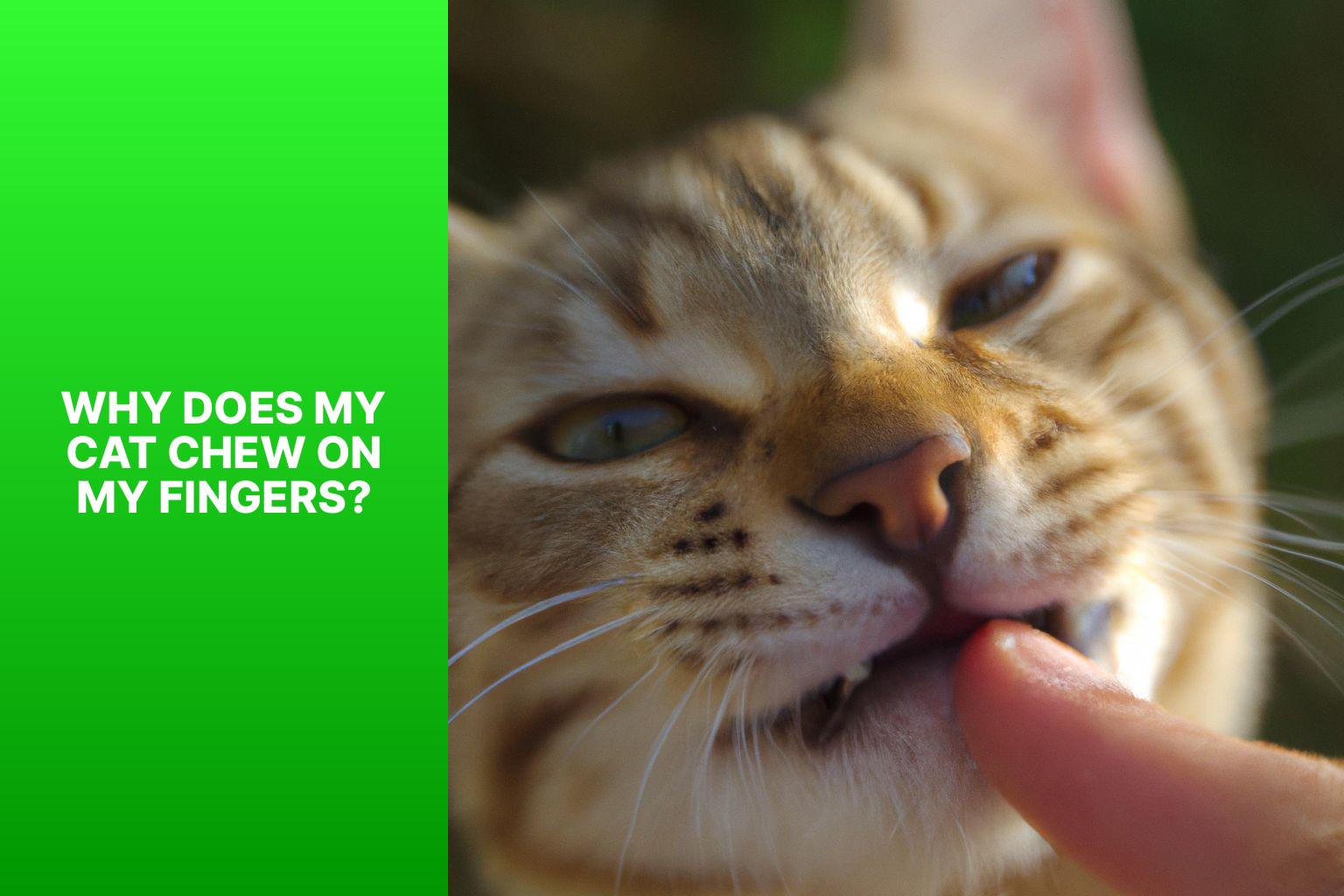Cats are known for their curious and sometimes peculiar behaviors, and one common behavior that can leave owners puzzled is when their cat chews on their fingers. Understanding the reasons behind this behavior is key to addressing it and ensuring the well-being of both you and your feline friend.
To comprehend why cats exhibit certain behaviors, it is important to have a basic understanding of their overall behavior patterns. Normal cat behavior involves activities such as grooming, hunting, territorial marking, and social interactions. When it comes to chewing, there can be various reasons why cats engage in this behavior.
There are several possible reasons why your cat may chew on your fingers. These include teething, affectionate behavior, playful behavior, exploration, and even marking territory.
Teething is a common reason for kittens to chew on objects, including fingers, as it helps alleviate the discomfort of their growing teeth. Some cats may chew on fingers as a form of affection or to show trust and familiarity. Cats may also engage in playful chewing as a way to interact with their owners. Their curiosity may also lead them to explore objects through chewing. Some cats may chew on fingers as a way to mark their territory by leaving their scent.
To redirect your cat’s chewing behavior, it is important to provide appropriate chew toys that they can safely explore and nibble on. Engaging in interactive play sessions can also help satisfy your cat’s need for stimulation and play. Using deterrents, such as bitter sprays or double-sided tape, can discourage chewing on fingers.
While chewing on fingers is often harmless, there are instances where it may be cause for concern. If your cat exhibits aggressive chewing, excessive drooling, discomfort, or starts swallowing or ingesting non-food items, it is recommended to consult with a veterinarian.
Training your cat using positive reinforcement techniques can help address and modify undesirable behaviors. Patience, consistency, and rewards for good behavior are key in training your cat effectively.
By understanding the reasons behind your cat’s chewing behavior and implementing appropriate strategies, you can better manage this behavior and ensure a harmonious relationship with your furry companion.
Key takeaway:
- Teething: Cats may chew on your fingers as a way to relieve teething discomfort.
- Affectionate Behavior: Chewing on fingers can be a sign of affection from your cat.
- Playful Behavior: Cats may chew on your fingers as part of their playful nature.
Why Does My Cat Chew on My Fingers?
Photo Credits: Www.Catcornerblog.Com by Billy Sanchez
Cats may chew on fingers for various reasons. Why does my cat chew on my fingers? Here are some possible explanations:
1. Teething: Kittens chew on objects, including fingers, to relieve teething discomfort.
2. Playtime: Cats explore and interact with their environment using their mouths. Chewing on fingers can be a playful behavior during interactive sessions.
3. Attention-seeking: Cats may bite or chew on fingers to get attention or communicate.
4. Affection: Some cats show love by gently nibbling on fingers, which is associated with grooming and trust.
5. Taste and texture: Cats have preferences for taste and texture. Fingers may have a tempting scent or interesting feel to chew on.
6. Stress or anxiety: Cats may chew on fingers as a coping mechanism for stress or anxiety. It’s important to identify and address the underlying cause if this behavior becomes excessive or compulsive.
If your cat’s finger chewing behavior becomes problematic or uncomfortable, consult a veterinarian or animal behaviorist for advice.
Understanding Cat Behavior
Understanding Cat Behavior
Cats are independent animals with unique behaviors and instincts.
Cat behavior is communicated through body language, such as tail movement, facial expressions, and ear positions.
Cats engage in play behavior to exercise, sharpen their hunting skills, and release excess energy.
Cats use scent marking to communicate their territory and presence, utilizing scent glands in their paws, cheeks, and tail base.
Cats have their own preferences for social interaction. Some may be more affectionate, while others may prefer to be alone.
Cats scratch to mark their territory, stretch their muscles, and groom their claws.
Cats have natural instincts to hunt and may exhibit stalking, pouncing, and capturing behaviors, even if they are well-fed.
Fact: Understanding cat behavior creates a harmonious and enriching environment for both cats and their owners.
What Is Normal Cat Behavior?
Normal cat behavior includes marking territory through scratching, rubbing against objects, and spraying urine. Grooming is important for cats to keep their fur clean and regulate body temperature. Cats are naturally curious and enjoy exploring their surroundings and investigating new things. Playfulness is a common trait in cats, and they engage in activities such as chasing toys and interacting with their owners. Kneading is another normal behavior, linked to their kittenhood. Understanding these behaviors helps create a suitable environment for cats and ensures their well-being.
Why Do Cats Chew?
Cats chew for various reasons. Understanding these motives can help you respond better to their behavior. Reasons why cats chew include teething, affectionate behavior, playful behavior, exploration and curiosity, and marking territory. Cats chew during teething to relieve discomfort and help their adult teeth emerge. Chewing can be a form of affectionate behavior, as cats groom and nibble on their owners’ fingers to show affection. Playful behavior can also involve chewing, with cats using their mouths to explore and interact with objects. Curiosity drives cats to taste and investigate things, leading to chewing behaviors. Cats may also chew on fingers to mark their territory.
To redirect your cat’s chewing behavior, provide safe and appealing chew toys. Engage in interactive play sessions to satisfy their need for stimulation and play, redirecting their chewing impulses. Use deterrents like bitter sprays or double-sided tape on fingers and belongings to discourage chewing. Monitor your cat’s chewing behavior to ensure they aren’t engaging in aggressive chewing, excessive drooling, or swallowing non-food items.
In ancient Egypt, cats were symbolic and revered creatures associated with various deities. Their hunting skills made them valuable companions for protecting food sources. Cats were even mummified and buried with their owners as a sign of honor. The bond between cats and humans has evolved over thousands of years, with chewing being one of the intriguing behaviors displayed by these fascinating animals.
Possible Reasons Why Your Cat Chews on Your Fingers
Curious why your feline friend keeps nibbling on your fingers? Let’s dive into the possible reasons behind this behavior. From teething to affectionate gestures, playful antics to exploring their world, and even marking their territory, we’ll unravel the motivations behind your cat’s nibbling habit. So, grab a cup of coffee and join me as we unravel the fascinating world of our furry companions and discover why they choose our fingers as their chew toys.
1. Teething
Teething is a natural process that occurs in kittens, where their baby teeth start to fall out and make way for their permanent teeth to grow. This phase can cause some discomfort or pain, which can lead your cat to chew on objects, including fingers, to find relief. Chewing on fingers during teething is a common behavior among kittens as they explore and soothe their gums.
To redirect your cat’s chewing behavior in this stage, it is important to provide appropriate chew toys such as rubber teething rings or soft toys designed for kittens. Engaging in interactive play sessions with toys that your cat can bite and chew on can also help. Using deterrents like bitter sprays or citrus scents on hands can discourage your cat from chewing on them.
If your cat’s chewing behavior becomes aggressive or is accompanied by excessive drooling or discomfort, it is advisable to consult a veterinarian. It is important to prevent your cat from swallowing or ingesting non-food items as they can be dangerous.
Pro-tip: Make sure to regularly check your cat’s mouth to ensure that their new teeth are growing properly, and provide appropriate items for them to chew on during the teething phase.
2. Affectionate Behavior
When a cat chews on your fingers, it may be a sign of affection. Cats may do this to show love and bond with their owners. Here are some possible reasons for this behavior:
- Seeking attention: Chewing on your fingers is a way for your cat to get your attention and seek affection.
- Comfort: Some cats find comfort in chewing on soft objects, like fingers, which helps calm them when they’re stressed.
- Mimicking nursing behavior: Kittens chew on their mother’s nipples while nursing, and this behavior can continue into adulthood as a way to seek comfort.
- Bonding: Chewing on your fingers is a sign of trust and intimacy. It shows that your cat feels close to you and wants to express their affection.
If you don’t like this behavior, you can redirect your cat’s chewing by providing appropriate chew toys, engaging in interactive play, and using bitter-tasting sprays to deter them. It’s important to observe your cat’s behavior and ensure they aren’t showing signs of aggression, excessive drooling, or discomfort while chewing. If you’re concerned about your cat’s chewing, consult a veterinarian or animal behaviorist for guidance. Remember to be patient and consistent in training to encourage positive behavior in your cat.
3. Playful Behavior
When your cat engages in playful behavior and chews on your fingers, there are several possible explanations. Cats use their mouths to explore and interact with the world, so playful nibbling on objects like fingers can be a form of engagement. Kittens may chew on fingers to alleviate discomfort as new teeth come in. Playfully biting fingers can also trigger a prey instinct in cats, mimicking the sensation of catching prey. Chewing on fingers can also indicate bonding and affection, similar to grooming. Some cats may bite fingers playfully as a way to seek attention or initiate playtime.
To redirect your cat’s chewing behavior, there are several strategies you can try. First, provide appropriate chew toys to satisfy your cat’s chewing needs. Offering a variety of safe and interactive toys can help divert their attention from your fingers. Engaging in regular play sessions with toys can help drain your cat’s excess energy and redirect their playful behavior. If chewing on fingers persists, you can use deterrent sprays or bitter-tasting substances on your hands to discourage this behavior.
It is essential to always provide positive reinforcement and reward your cat when they engage in appropriate chewing behavior. If you have concerns about your cat’s chewing habits, it is best to consult with a veterinarian.
4. Exploration and Curiosity
Cats chew on fingers out of curiosity and exploration. They use their mouths to investigate new objects and textures, including your fingers. By chewing, they try to understand your scent and taste, which helps them to get to know you better and interact with you.
To redirect your cat’s chewing behavior, follow these steps:
- – Provide appropriate chew toys designed for cats, offering various textures and materials for exploration.
- – Engage in interactive play sessions with your cat to keep them mentally and physically stimulated, diverting their attention from chewing on fingers.
- – Use deterrents like bitter apple spray on fingers to discourage cats from chewing on them.
If your cat’s chewing behavior becomes aggressive, seek professional advice from a veterinarian or animal behaviorist. Excessive drooling or discomfort while chewing may indicate dental issues or oral pain, requiring a vet’s examination. Swallowing or ingesting non-food items can be a sign of a behavioral or medical problem that needs attention.
Fact: Cats have approximately 30 to 32 teeth, including incisors, canines, premolars, and molars.
5. Marking Territory
Cats have scent glands in their paws and may chew on objects, including fingers, to mark their territory. Redirect your cat’s behavior by providing appropriate objects to chew on, such as interactive toys or scratching posts.
Reinforce positive behavior by rewarding your cat with treats or praise when they chew on designated objects instead of your fingers. If your cat starts chewing on your fingers, gently redirect their attention to the appropriate objects.
Avoid scolding or punishing them, as this can create negative associations and lead to further behavioral issues. Each cat is unique, so understanding their individual needs and preferences is important.
Seeking advice from a veterinarian or animal behaviorist can also help manage marking behavior and foster a harmonious relationship with your cat.
How to Redirect Your Cat’s Chewing Behavior
Discover effective strategies to redirect your cat’s chewing behavior in this insightful section. Learn how to provide appropriate chew toys that satisfy your feline friend’s natural instincts. Engage in interactive play sessions to keep your cat mentally stimulated and discourage them from nibbling on your fingers. Explore the use of deterrents to create boundaries and redirect their chewing behavior towards more suitable objects. Say goodbye to unwanted finger munching as we guide you through these practical solutions.
1. Provide Appropriate Chew Toys
“Provide Appropriate Chew Toys:
When redirecting your cat’s chewing behavior, it is essential to provide them with chew toys that are specifically designed for cats. It is important to choose toys that are made of durable materials such as rubber or nylon. Make sure to select toys that are the appropriate size and avoid small ones that can potentially be swallowed or become a choking hazard. To keep your cat engaged and stimulated, offer them a variety of chew toys that have different textures and shapes. You can introduce these toys to your cat by placing them in accessible areas and encouraging play. It is also recommended to regularly rotate the chew toys to prevent boredom and maintain their interest. Keep an eye on your cat’s preferences to determine which toys are their favorites. It is crucial to inspect the toys regularly for any signs of wear and tear and replace damaged toys for the safety of your cat. Always remember that providing appropriate chew toys can effectively redirect your cat’s chewing behavior and keep them engaged and satisfied.”
2. Engage in Interactive Play Sessions
Edited
2. Engage in Interactive Play Sessions
Engaging in interactive play sessions with your cat can redirect their chewing behavior. Follow these steps:
1. Choose interactive toys that stimulate your cat’s natural hunting instincts, such as feather wands or laser pointers. These toys keep them engaged and provide an appropriate outlet for their chewing behavior.
2. Set aside dedicated playtime each day to engage with your cat. Use the interactive toys and encourage them to chase, pounce, and bat at the toys. This not only distracts them from chewing on your fingers but also fulfills their need for mental and physical stimulation.
3. Make the play sessions more challenging by hiding treats or toys around the house for your cat to find. This encourages them to explore and hunt for rewards, diverting their attention from inappropriate chewing.
4. Rotate the toys regularly to keep your cat interested. Introduce new toys or rotate their existing ones to prevent boredom and ensure their engagement during play sessions.
5. Be patient and consistent with your cat’s play sessions. Regularly engaging in interactive play reinforces positive behaviors and helps deter them from chewing on your fingers.
6. Observe your cat’s behavior during play sessions. If you notice any signs of aggression or discomfort, immediately stop the play session and consult with a veterinarian or animal behaviorist for guidance.
Remember, interactive play sessions are beneficial for redirecting your cat’s chewing behavior and strengthening the bond between you and your feline companion.
3. Use Deterrents
When deterring your cat from chewing on your fingers, incorporate these strategies:
1. Use bitter sprays or deterrents: Apply a bitter-tasting spray or deterrent directly to your fingers. Cats naturally dislike the taste and will cease chewing when they encounter the unpleasant sensation.
2. Offer alternative toys: Provide your cat with enticing chew toys to redirect their chewing behavior.
3. Try a motion-activated deterrent: Startle your cat by using a motion-activated device that releases a burst of air or emits a loud noise whenever they attempt to chew on your fingers.
Remember, consistency and patience are key. It may take some time for your cat to learn that chewing on your fingers is not acceptable. Stay persistent with the chosen deterrent method and reinforce positive behavior by redirecting their attention to an appropriate chew toy.
When to Be Concerned about Your Cat’s Chewing Behavior
Are you worried about your cat’s chewing behavior? Let’s dive into when exactly you should be concerned. We’ll explore three key indicators: aggressive chewing, excessive drooling or discomfort, and swallowing or ingesting non-food items. By understanding these warning signs, you’ll be able to take better care of your furry friend and ensure their wellbeing. So, let’s unravel the mystery behind your cat’s chewing habits and address any potential issues they might be facing.
1. Aggressive Chewing
Aggressive chewing in cats may indicate underlying issues. Addressing this behavior is vital for the safety and well-being of your cat and yourself.
1. Pain or Discomfort: Aggressive chewing in cats may indicate dental problems or oral pain. Tooth decay, gum disease, or oral injuries can lead to aggressive chewing as a way to alleviate discomfort.
2. Stress or Anxiety: Cats may chew aggressively when feeling stressed or anxious. This behavior can be a coping mechanism to release pent-up emotions or frustration.
3. Territorial Behavior: Cats may exhibit aggressive chewing to mark their territory. They may chew on significant objects, like fingers, to establish ownership and dominance.
4. Redirected Aggression: Cats may engage in aggressive chewing due to redirected aggression. When unable to target the source of their frustration or aggression directly, they redirect it towards you or nearby objects.
5. Medical Conditions: Certain medical conditions, such as hyperthyroidism or neurological disorders, can cause aggressive chewing in cats. Consulting with a veterinarian is necessary to rule out any underlying health issues.
If your cat displays aggressive chewing behavior, address the underlying cause using these suggestions:
1. Consult a veterinarian: If dental problems or a medical condition are suspected, seek professional help. A veterinarian can examine your cat and provide appropriate treatment or medication.
2. Provide appropriate chew toys: Offer your cat safe and durable chew toys to redirect their chewing behavior. Interactive toys that encourage mental stimulation and satisfy their chewing instincts can be beneficial.
3. Environmental enrichment: Enhance your cat’s environment with scratching posts, climbing structures, and interactive toys to prevent boredom and stress. This can help reduce the likelihood of aggressive chewing.
4. Positive reinforcement: Reward your cat for appropriate chewing behavior with treats, praise, or playtime. This will reinforce desirable behaviors and discourage aggressive chewing.
5. Seek professional help: If the aggressive chewing behavior persists or worsens despite your efforts, consult with a certified animal behaviorist or professional cat trainer. They can provide specialized guidance and techniques to modify your cat’s behavior.
2. Excessive Drooling or Discomfort
Excessive drooling or discomfort in cats may indicate underlying health issues. Possible reasons for excessive drooling or discomfort include dental problems, oral infections, foreign objects, oral ulcers or sores, and orofacial pain syndrome. If your cat experiences these symptoms, it is essential to consult a veterinarian for diagnosis and treatment. The veterinarian can identify the cause and recommend steps to alleviate discomfort and improve your cat’s well-being. Seek veterinary care if you notice concerning symptoms in your cat to ensure their health and comfort.
3. Swallowing or Ingesting Non-Food Items
Swallowing or ingesting non-food items in cats can be concerning. It’s important to address this issue to prevent potential health problems. Here are some reasons why cats engage in this behavior:
– Pica: Cats with pica consume non-food items, indicating a nutritional deficiency or underlying health issue.
– Exploration and curiosity: Cats explore objects with their mouths and may accidentally swallow them.
– Anxiety or stress: Cats chew or swallow non-food items as a coping mechanism for anxiety or stress, indicating underlying emotional issues.
– Dental problems: Cats with dental issues may chew non-food items to alleviate discomfort.
– Boredom: Cats that are bored or lack mental stimulation may chew or swallow non-food items for entertainment.
If you notice your cat swallowing or ingesting non-food items, take action to prevent harm. Here are some tips to redirect this behavior:
1. Remove potential hazards: Eliminate access to non-food items your cat may chew or swallow.
2. Provide appropriate chew toys: Offer a variety of safe and engaging chew toys to satisfy your cat’s natural instincts.
3. Keep your cat mentally stimulated: Engage in interactive play sessions to prevent boredom.
4. Consult a veterinarian: If the behavior persists or your cat shows signs of distress, seek guidance from a veterinarian.
By addressing this issue and providing appropriate outlets for chewing and stimulation, you can prevent potential health concerns associated with swallowing or ingesting non-food items.
Tips for Training Your Cat
Tips for Training Your Cat
Training cats can be challenging, but with patience and the right approach, it is possible to teach them basic behaviors. Here are some tips for training your cat:
- Start with positive reinforcement: Cats respond well to positive reinforcement. Reward your cat with treats, praises, or playtime when they exhibit the desired behavior. This reinforces the behavior and encourages them to repeat it.
- Use clicker training: Clicker training is a popular method for training cats. It involves using a clicker to make a distinct sound followed by a treat. The clicker marks the desired behavior, and the treat serves as a reward. Eventually, your cat will associate the clicker sound with a reward and learn the desired behavior.
- Be consistent: Consistency is key when training cats. Use the same cues and commands every time, and ensure everyone in your household follows the same training approach. This helps your cat understand expectations and makes training more effective.
- Keep training sessions short: Cats have short attention spans, so it’s important to keep sessions brief and engaging. Aim for sessions that are 10-15 minutes long, and try to end on a positive note, even if your cat hasn’t fully mastered the behavior yet.
- Be patient: Training takes time, and cats have unique personalities and learning paces. Be patient and celebrate small victories along the way. It may take time for them to fully grasp a behavior, but with consistency and positive reinforcement, they will get there.
Remember, every cat is different, so what works for one may not work for another. Find what motivates your cat and tailor your training approach to their needs and preferences. With these tips and love and patience, you can successfully train your cat.
Some Facts About Why Cats Chew on Fingers:
- ✅ Cats may chew on fingers as a way to show love and affection, a behavior they learned from their mothers. (Source: Reddit)
- ✅ Cats may pounce on their owner’s hand and chew on fingers as a way to release excess energy and practice their hunting skills. (Source: Hepper)
- ✅ If a cat is overstimulated by excessive petting, they may bite fingers as a way to communicate that they’ve had enough. (Source: Hepper)
- ✅ Kittens may chew on fingers when they are teething to alleviate discomfort. Providing them with chew toys can help redirect this behavior. (Source: Hepper)
- ✅ Cats may chew on fingers when they are stressed as a way to self-soothe. Providing them with a chew toy can help alleviate their anxiety. (Source: PetKeen)



